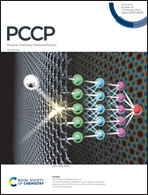Excellent thermoelectric properties of monolayer RbAgM (M = Se and Te): first-principles calculations
Abstract
Based on the atomic substitution method, the RbAgM monolayers (M = Se and Te), a class of derivative compounds of KAgSe, have been successfully predicted, which exhibit ultra-high mobility and poor heat transport ability, indicating their broad application potential in thermoelectric (TE) technology. Using density functional theory (DFT) and the Boltzmann transport equation (BTE), we carry out systematic studies on their electronic band structures, heat transport abilities and TE properties. Our calculated results show that the RbAgTe monolayer possesses ultra-low lattice thermal conductivity (0.90 W m−1 K−1) at room temperature and a high Seebeck coefficient (2320 μV K−1). Additionally, we also focus on the analysis of phonon velocity and Grüneisen parameter to further explain their ultra-low thermal conductivity. By combining these calculated parameters, the predicted maximum ZT values of RbAgSe and RbAgTe are as high as 2.2 and 4.1 at 700 K with optimum n-type doping, respectively, which are comparable to that of the famous TE material SnSe (ZT = 2.6 at 923 K). Our research results provide a strong theoretical basis for the experimental exploration of the TE properties of RbAgM, and help to promote further experimental verification.



 Please wait while we load your content...
Please wait while we load your content...